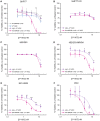NRXN1 as a novel potential target of antibody-drug conjugates for small cell lung cancer
- PMID: 33062195
- PMCID: PMC7533074
- DOI: 10.18632/oncotarget.27718
NRXN1 as a novel potential target of antibody-drug conjugates for small cell lung cancer
Abstract
Small cell lung cancer (SCLC) is a high-grade malignancy, and treatment strategies have not changed for decades. In this study, we searched for novel targets for antibody-drug conjugate (ADC) therapy for SCLC. We identified transmembrane proteins overexpressed specifically in SCLC with little or no expression in normal tissues and decided to focus on the cell adhesion molecule neurexin-1 (NRXN1). The cell surface overexpression of NRXN1 was confirmed using flow cytometry in SCLC cell lines (SHP77 and NCI-H526). The combination of a primary anti-NRXN1 monoclonal antibody and a secondary ADC exhibited anti-tumor activity in SCLC cell lines. Moreover, the knockout of NRXN1 in SHP77 cells resulted in a loss of the anti-tumor activity of NRXN1-mediated ADC therapy. Thus, NRXN1 could be a novel target for ADC therapy for the treatment of SCLC that is worth further research.
Keywords: NRXN1; antibody-drug conjugates; cell adhesion molecule; novel molecular targets; small cell lung cancer.
Conflict of interest statement
CONFLICTS OF INTEREST Authors have no conflicts of interest to declare.
Figures




Similar articles
-
A Newly Developed Anti-L1CAM Monoclonal Antibody Targets Small Cell Lung Carcinoma Cells.Int J Mol Sci. 2024 Aug 11;25(16):8748. doi: 10.3390/ijms25168748. Int J Mol Sci. 2024. PMID: 39201435 Free PMC article.
-
Junctional adhesion molecule 3 is a potential therapeutic target for small cell lung carcinoma.Exp Cell Res. 2023 May 15;426(2):113570. doi: 10.1016/j.yexcr.2023.113570. Epub 2023 Mar 27. Exp Cell Res. 2023. PMID: 36990421
-
Assessment of targets of antibody drug conjugates in SCLC.NPJ Precis Oncol. 2025 Jan 2;9(1):1. doi: 10.1038/s41698-024-00784-7. NPJ Precis Oncol. 2025. PMID: 39748112 Free PMC article.
-
Tumor-Targeted Drug Conjugates as an Emerging Novel Therapeutic Approach in Small Cell Lung Cancer (SCLC).Cancers (Basel). 2019 Sep 3;11(9):1297. doi: 10.3390/cancers11091297. Cancers (Basel). 2019. PMID: 31484422 Free PMC article. Review.
-
Small Cell Lung Cancer: Emerging Targets and Strategies for Precision Therapy.Cancers (Basel). 2023 Aug 8;15(16):4016. doi: 10.3390/cancers15164016. Cancers (Basel). 2023. PMID: 37627044 Free PMC article. Review.
Cited by
-
Unlocking New Horizons in Small-Cell Lung Cancer Treatment: The Onset of Antibody-Drug Conjugates.Cancers (Basel). 2023 Nov 10;15(22):5368. doi: 10.3390/cancers15225368. Cancers (Basel). 2023. PMID: 38001628 Free PMC article. Review.
-
Role of miRNA-495 and NRXN-1 and CNTN-1 mRNA Expression and Its Prognostic Importance in Breast Cancer Patients.J Oncol. 2021 Oct 8;2021:9657071. doi: 10.1155/2021/9657071. eCollection 2021. J Oncol. 2021. PMID: 34659414 Free PMC article.
-
Small Cell Lung Cancer Neuronal Features and Their Implications for Tumor Progression, Metastasis, and Therapy.Mol Cancer Res. 2024 Sep 4;22(9):787-795. doi: 10.1158/1541-7786.MCR-24-0265. Mol Cancer Res. 2024. PMID: 38912893 Free PMC article. Review.
-
LINE-1 hypomethylation is associated with poor outcomes in locoregionally advanced oropharyngeal cancer.Clin Epigenetics. 2022 Dec 12;14(1):171. doi: 10.1186/s13148-022-01386-5. Clin Epigenetics. 2022. PMID: 36503584 Free PMC article.
-
NRXN1 as a Prognostic Biomarker: Linking Copy Number Variation to EMT and Survival in Colon Cancer.Int J Mol Sci. 2024 Oct 24;25(21):11423. doi: 10.3390/ijms252111423. Int J Mol Sci. 2024. PMID: 39518976 Free PMC article.
References
-
- Horn L, Mansfield AS, Szczęsna A, Havel L, Krzakowski M, Hochmair MJ, Huemer F, Losonczy G, Johnson ML, Nishio M, Reck M, Mok T, Lam S, et al.. First-Line Atezolizumab plus Chemotherapy in Extensive-Stage Small-Cell Lung Cancer. N Engl J Med. 2018; 379:2220–2229. 10.1056/NEJMoa1809064. - DOI - PubMed
LinkOut - more resources
Full Text Sources

